Like many with a penchant for historical charm, I often find myself captivated by the elegance of Victorian gowns, dreaming of a time defined by layers, rich colors, ribbons, and refined grace. As a woman deeply rooted in the Southwest, born in Arizona and now residing in Denver, with lineage tracing back to Utah Pioneers, I’ve become fascinated by the practical yet stylish clothing of pioneer women. This blend of personal interest and regional heritage sparked a curiosity about pioneer clothing and how the fashions on the Western frontier diverged from those in established Eastern cities during the 19th century.
Pioneer women navigated a unique set of considerations when it came to their wardrobes, balancing practicality with societal expectations. From the need for durable, functional garments to expressions of personal style and social decorum, their clothing tells a story of adaptation and resilience. This exploration delves into the essential elements of pioneer women’s attire, uncovering the basics of their wardrobes and highlighting the fascinating intersection of necessity and fashion in the 1800s.
What Defined the Frontier Wardrobe?
For the scope of this discussion, “frontier” refers to the regions west of Missouri and Arkansas, primarily during the period from roughly 1850 to 1890. The clothing styles examined here are representative of women homesteaders and those living in settlement communities during this era. While acknowledging the diverse populations of the West, this article primarily focuses on the clothing of white settlers migrating westward from the East.
What’s particularly compelling about pioneer clothing is its emphasis on shared experience over social status. Unlike the fashion-driven societies of the East, frontier wardrobes were less about outward displays of wealth and more about the common journey and aspirations of families forging new lives in the unexplored West. Clothing became a symbol of resilience and adaptability, reflecting the practical demands of frontier life and the enduring spirit of those who embraced it.
Layers Beneath: Pioneer Undergarments
Interestingly, the foundational undergarments worn by women in frontier regions didn’t drastically differ from those in eastern cities. The cornerstone was the chemise, a lightweight cotton slip. Its primary function was hygiene, acting as a barrier between the body and outer garments and being laundered frequently. Pantalets, typically made of flannel or cotton, were another essential layer, serving purposes of modesty in an era where undergarments as we know them were not yet common.
Contrary to initial assumptions that pioneer life might have meant abandoning certain societal norms, many frontier women continued to wear corsets. The women venturing west, often driven by hopes for economic advancement or religious freedom, were “proper” women of their time. Maintaining standards of dress, including wearing a corset, was a significant aspect of their identity and respectability.
While the physical demands of frontier life may have led some women to loosen or temporarily forgo corsets while performing strenuous tasks, the corset remained a staple garment. It was brought west and worn as often as circumstances allowed, representing a connection to their past lives and a commitment to maintaining a sense of order and propriety in a new environment.
Following the corset, petticoats were added, often multiple layers depending on the weather or formality of the occasion. Stockings were considered essential for modesty and warmth when leaving the house or receiving visitors. Held up by garters or tucked into pantalets, stockings completed the undergarment ensemble, although the latter method does seem like it would be quite uncomfortable by today’s standards!
Fabrics of the Frontier: Practical Choices
Calico emerged as the quintessential fabric for frontier clothing. Often visualized as quaint floral prints, calico is actually a type of plain-woven cotton fabric, slightly lighter than modern canvas. Its characteristics – lightweight yet sturdy, and relatively easy to clean – made it ideal for the rigors of outdoor life. General stores often stocked calico in various dyed options. Alternatively, women resourceful in nature, would dye the fabric themselves using commercially available dyes or natural pigments extracted from local plants like leaves, bark, berries, and fruits.
For more formal occasions like church services or social gatherings, cotton and even silk fabrics were still valued. Many women brought along dresses made from these finer materials from their former homes in the East.
While general stores provided access to fabrics, their availability varied greatly depending on location and proximity to settlements. In more remote areas, families might have relied on homespun fabrics, a fascinating topic deserving of its own dedicated exploration.
Daily Dresses: Functionality Meets Fashion
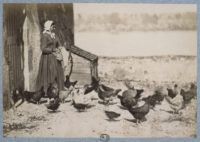 Pioneer woman in daily wear
Pioneer woman in daily wear
Regardless of their backgrounds, women on the frontier were integral to the establishment and maintenance of homes and farms. Daily life involved a demanding array of physical labor, including cooking, cleaning, childcare, laundry, and often, fieldwork. The prosperity of frontier families depended on the contributions of each member, and domestic tasks were not outsourced. Frontier women adapted quickly to a lifestyle filled with manual labor.
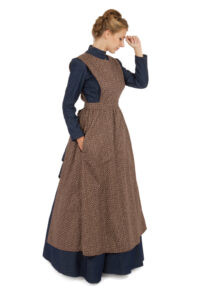 Pioneer Calico Apron for daily wear
Pioneer Calico Apron for daily wear
The prevailing dress styles of the era, characterized by fitted bodices and full skirts, were adopted by pioneer women but with practical modifications. For everyday wear, skirts were hemmed approximately three inches shorter than fashionable lengths to facilitate movement and daily tasks. Weights were sometimes sewn into the hems to prevent skirts from blowing up in windy conditions, ensuring modesty and practicality.
Bodices remained fitted, reflecting the fashionable silhouette of the time, but sleeves were often loosened for greater comfort and extended to the wrists, paired with high collars to protect the skin from the sun’s harsh rays.
Laundry was a significant undertaking on the frontier. In Chris Enss’s book, How the West Was Worn, the concept of “wash dresses” is mentioned. These were practical, two-piece dresses made of white cotton with printed patterns, introduced around 1867. Their popularity stemmed from their easy care and ability to be laundered frequently and effectively. “Wash dresses” were worn across socioeconomic lines, highlighting the frontier’s need for functional and easily maintainable clothing. This adaptation in fashion underscores how quickly clothing evolved to meet the specific needs of families living in the West.
Sunday Best: Church and Community
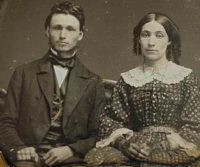 Pioneer couple in their Sunday best
Pioneer couple in their Sunday best
Even in sparsely populated frontier settlements, communities often formed around churches. Church attendance was generally considered a social norm, fostering community cohesion. While accounts exist of women in impoverished communities attending church barefoot, it was more common for women to possess at least one or two dresses specifically reserved for Sundays. Historical records, often skewed towards more privileged settlers, suggest that Sunday best was an important aspect of frontier life.
Frontier women’s “Sunday best” closely mirrored contemporary fashions in eastern cities. Full skirts, supported by petticoats and corsets, remained essential. Sleeve styles of the period, such as bell, leg-o-mutton, or pagoda sleeves, were incorporated into Sunday dresses. Skirt styles also evolved with fashion trends, reflecting the current silhouette, whether crinoline, hoop, or bustle.
Color choices for Sunday dresses varied with age and marital status. Younger women and newlyweds often favored lighter colors, transitioning to darker hues as they aged. Sunday ensembles were completed with the most fashionable hats available, along with kid gloves and low-heeled boots, representing a conscious effort to maintain social graces even in a rugged environment.
Social Occasions: Frontier Festivities
Beyond daily and Sunday attire, women in frontier communities, when resources permitted, also maintained separate dresses for social events. Dances, holiday celebrations, picnics, and other community gatherings were vital for social connection. Mirroring customs in eastern cities, dressing appropriately for these occasions was important.
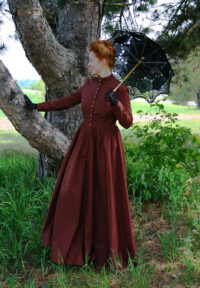 Pioneer woman in a church or social dress
Pioneer woman in a church or social dress
These social dresses were highly valued. Women might order fabrics from general stores, eagerly anticipating the chance to create fashionable garments. Godey’s Lady’s Book, a popular magazine, served as a crucial fashion guide, with patterns and styles enthusiastically copied and circulated among frontier women.
Fabric availability for creating new dresses depended heavily on the distance to towns and general stores. In more isolated areas, women might have had a limited wardrobe, adapting their best dress for special occasions by adding embellishments. Accessories like hand-crocheted collars and shawls became popular for dressing up simpler garments, highlighting the resourcefulness and creativity of frontier women in expressing personal style.
Accessorizing on the Frontier
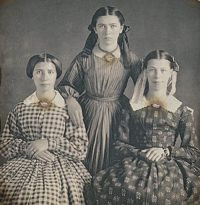 Frontier girls with accessories
Frontier girls with accessories
An important aspect of pioneer women’s wardrobes, often underestimated, is the significance of accessories. Beyond the foundational garments, accessories played a crucial role in completing and personalizing outfits. Jewelry and accessories were highly valued, adding touches of elegance and individuality to even the simplest frontier ensembles.
Women on the frontier adorned themselves with a variety of accessories, including:
- Aprons: Essential for daily tasks, aprons protected dresses and added a layer of practicality.
- Boots: Sturdy footwear was necessary for navigating varied terrains.
- Brooches: Decorative pins used to fasten clothing and add ornamentation.
- Lockets: Sentimental jewelry holding personal keepsakes.
- Earrings: A common form of personal adornment.
- Precious stones and metals: Though perhaps less abundant than in the East, these were still cherished when available.
- Hair adornments: Ribbons, combs, and other decorations for hairstyles.
- Hats: Crucial for sun protection and completing an outfit.
- Collars and cuffs: Often detachable and ornamental, adding detail to dresses.
- Gloves: Worn for warmth and formality.
- Undersleeves: Detachable sleeves worn for modesty or to change the look of a dress.
- Parasols: Used for sun protection and as a stylish accessory.
- Fans: For cooling and as a fashionable accessory.
- Handbags: Small bags for carrying personal items.
- Shawls: Versatile wraps for warmth and style.
A Surviving Legacy
My growing interest in my own pioneer ancestors has deepened my appreciation for this era. While “prairie style,” “pioneer,” and “western wear” clothing are readily available today, understanding the historical context of how women balanced propriety, beauty, and fashion within the demanding realities of frontier life is truly fascinating.
This exploration is just the beginning. I look forward to further investigating frontier fashion, with a follow-up post dedicated to the captivating world of accessories in the frontier.
Create your own pioneer look:
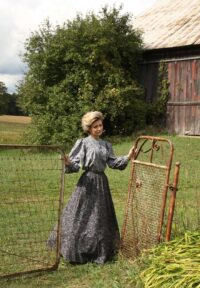 Woman in pioneer dress
Woman in pioneer dress
Browse our entire pioneer clothing collection
Pioneer Calico Blouse and Skirt
Harper Victorian Pioneer Dress
Pioneer Blouse, Apron and Skirt
